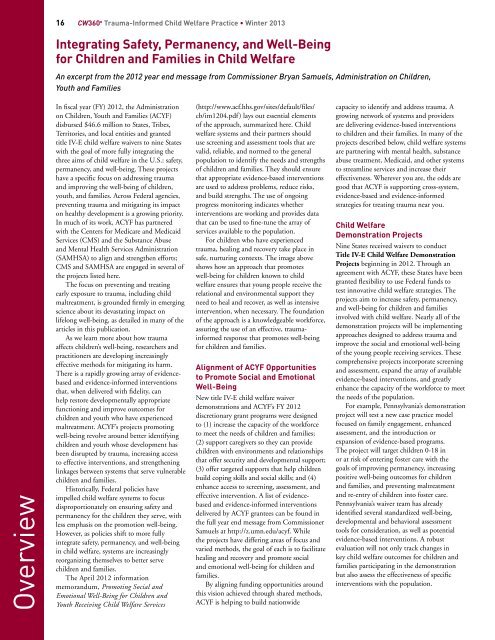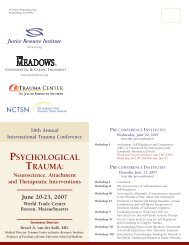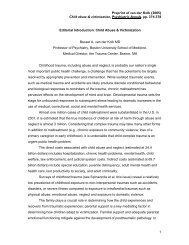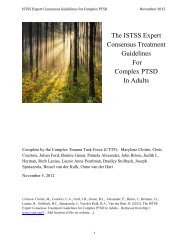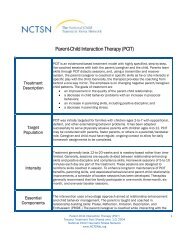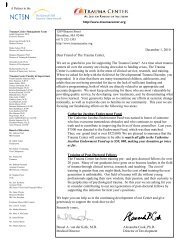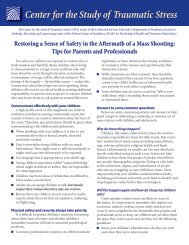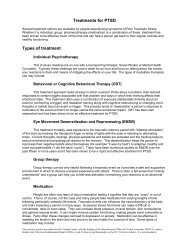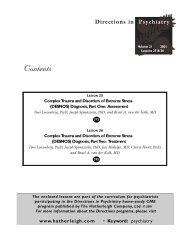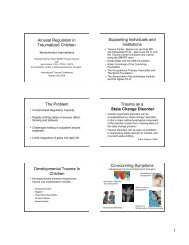in Child Welfare - The Trauma Center
in Child Welfare - The Trauma Center
in Child Welfare - The Trauma Center
Create successful ePaper yourself
Turn your PDF publications into a flip-book with our unique Google optimized e-Paper software.
16 CW360 o <strong>Trauma</strong>-Informed <strong>Child</strong> <strong>Welfare</strong> Practice • W<strong>in</strong>ter 2013Integrat<strong>in</strong>g Safety, Permanency, and Well-Be<strong>in</strong>gfor <strong>Child</strong>ren and Families <strong>in</strong> <strong>Child</strong> <strong>Welfare</strong>An excerpt from the 2012 year end message from Commissioner Bryan Samuels, Adm<strong>in</strong>istration on <strong>Child</strong>ren,Youth and FamiliesOverviewIn fiscal year (FY) 2012, the Adm<strong>in</strong>istrationon <strong>Child</strong>ren, Youth and Families (ACYF)disbursed $46.6 million to States, Tribes,Territories, and local entities and grantedtitle IV-E child welfare waivers to n<strong>in</strong>e Stateswith the goal of more fully <strong>in</strong>tegrat<strong>in</strong>g thethree aims of child welfare <strong>in</strong> the U.S.: safety,permanency, and well-be<strong>in</strong>g. <strong>The</strong>se projectshave a specific focus on address<strong>in</strong>g traumaand improv<strong>in</strong>g the well-be<strong>in</strong>g of children,youth, and families. Across Federal agencies,prevent<strong>in</strong>g trauma and mitigat<strong>in</strong>g its impacton healthy development is a grow<strong>in</strong>g priority.In much of its work, ACYF has partneredwith the <strong>Center</strong>s for Medicare and MedicaidServices (CMS) and the Substance Abuseand Mental Health Services Adm<strong>in</strong>istration(SAMHSA) to align and strengthen efforts;CMS and SAMHSA are engaged <strong>in</strong> several ofthe projects listed here.<strong>The</strong> focus on prevent<strong>in</strong>g and treat<strong>in</strong>gearly exposure to trauma, <strong>in</strong>clud<strong>in</strong>g childmaltreatment, is grounded firmly <strong>in</strong> emerg<strong>in</strong>gscience about its devastat<strong>in</strong>g impact onlifelong well-be<strong>in</strong>g, as detailed <strong>in</strong> many of thearticles <strong>in</strong> this publication.As we learn more about how traumaaffects children’s well-be<strong>in</strong>g, researchers andpractitioners are develop<strong>in</strong>g <strong>in</strong>creas<strong>in</strong>glyeffective methods for mitigat<strong>in</strong>g its harm.<strong>The</strong>re is a rapidly grow<strong>in</strong>g array of evidencebasedand evidence-<strong>in</strong>formed <strong>in</strong>terventionsthat, when delivered with fidelity, canhelp restore developmentally appropriatefunction<strong>in</strong>g and improve outcomes forchildren and youth who have experiencedmaltreatment. ACYF’s projects promot<strong>in</strong>gwell-be<strong>in</strong>g revolve around better identify<strong>in</strong>gchildren and youth whose development hasbeen disrupted by trauma, <strong>in</strong>creas<strong>in</strong>g accessto effective <strong>in</strong>terventions, and strengthen<strong>in</strong>gl<strong>in</strong>kages between systems that serve vulnerablechildren and families.Historically, Federal policies haveimpelled child welfare systems to focusdisproportionately on ensur<strong>in</strong>g safety andpermanency for the children they serve, withless emphasis on the promotion well-be<strong>in</strong>g.However, as policies shift to more fully<strong>in</strong>tegrate safety, permanency, and well-be<strong>in</strong>g<strong>in</strong> child welfare, systems are <strong>in</strong>creas<strong>in</strong>glyreorganiz<strong>in</strong>g themselves to better servechildren and families.<strong>The</strong> April 2012 <strong>in</strong>formationmemorandum, Promot<strong>in</strong>g Social andEmotional Well-Be<strong>in</strong>g for <strong>Child</strong>ren andYouth Receiv<strong>in</strong>g <strong>Child</strong> <strong>Welfare</strong> Services(http://www.acf.hhs.gov/sites/default/files/cb/im1204.pdf) lays out essential elementsof the approach, summarized here. <strong>Child</strong>welfare systems and their partners shoulduse screen<strong>in</strong>g and assessment tools that arevalid, reliable, and normed to the generalpopulation to identify the needs and strengthsof children and families. <strong>The</strong>y should ensurethat appropriate evidence-based <strong>in</strong>terventionsare used to address problems, reduce risks,and build strengths. <strong>The</strong> use of ongo<strong>in</strong>gprogress monitor<strong>in</strong>g <strong>in</strong>dicates whether<strong>in</strong>terventions are work<strong>in</strong>g and provides datathat can be used to f<strong>in</strong>e-tune the array ofservices available to the population.For children who have experiencedtrauma, heal<strong>in</strong>g and recovery take place <strong>in</strong>safe, nurtur<strong>in</strong>g contexts. <strong>The</strong> image aboveshows how an approach that promoteswell-be<strong>in</strong>g for children known to childwelfare ensures that young people receive therelational and environmental support theyneed to heal and recover, as well as <strong>in</strong>tensive<strong>in</strong>tervention, when necessary. <strong>The</strong> foundationof the approach is a knowledgeable workforce,assur<strong>in</strong>g the use of an effective, trauma<strong>in</strong>formedresponse that promotes well-be<strong>in</strong>gfor children and families.Alignment of ACYF Opportunitiesto Promote Social and EmotionalWell-Be<strong>in</strong>gNew title IV-E child welfare waiverdemonstrations and ACYF’s FY 2012discretionary grant programs were designedto (1) <strong>in</strong>crease the capacity of the workforceto meet the needs of children and families;(2) support caregivers so they can providechildren with environments and relationshipsthat offer security and developmental support;(3) offer targeted supports that help childrenbuild cop<strong>in</strong>g skills and social skills; and (4)enhance access to screen<strong>in</strong>g, assessment, andeffective <strong>in</strong>tervention. A list of evidencebasedand evidence-<strong>in</strong>formed <strong>in</strong>terventionsdelivered by ACYF grantees can be found <strong>in</strong>the full year end message from CommissionerSamuels at http://z.umn.edu/acyf. Whilethe projects have differ<strong>in</strong>g areas of focus andvaried methods, the goal of each is to facilitateheal<strong>in</strong>g and recovery and promote socialand emotional well-be<strong>in</strong>g for children andfamilies.By align<strong>in</strong>g fund<strong>in</strong>g opportunities aroundthis vision achieved through shared methods,ACYF is help<strong>in</strong>g to build nationwidecapacity to identify and address trauma. Agrow<strong>in</strong>g network of systems and providersare deliver<strong>in</strong>g evidence-based <strong>in</strong>terventionsto children and their families. In many of theprojects described below, child welfare systemsare partner<strong>in</strong>g with mental health, substanceabuse treatment, Medicaid, and other systemsto streaml<strong>in</strong>e services and <strong>in</strong>crease theireffectiveness. Wherever you are, the odds aregood that ACYF is support<strong>in</strong>g cross-system,evidence-based and evidence-<strong>in</strong>formedstrategies for treat<strong>in</strong>g trauma near you.<strong>Child</strong> <strong>Welfare</strong>Demonstration ProjectsN<strong>in</strong>e States received waivers to conductTitle IV-E <strong>Child</strong> <strong>Welfare</strong> DemonstrationProjects beg<strong>in</strong>n<strong>in</strong>g <strong>in</strong> 2012. Through anagreement with ACYF, these States have beengranted flexibility to use Federal funds totest <strong>in</strong>novative child welfare strategies. <strong>The</strong>projects aim to <strong>in</strong>crease safety, permanency,and well-be<strong>in</strong>g for children and families<strong>in</strong>volved with child welfare. Nearly all of thedemonstration projects will be implement<strong>in</strong>gapproaches designed to address trauma andimprove the social and emotional well-be<strong>in</strong>gof the young people receiv<strong>in</strong>g services. <strong>The</strong>secomprehensive projects <strong>in</strong>corporate screen<strong>in</strong>gand assessment, expand the array of availableevidence-based <strong>in</strong>terventions, and greatlyenhance the capacity of the workforce to meetthe needs of the population.For example, Pennsylvania’s demonstrationproject will test a new case practice modelfocused on family engagement, enhancedassessment, and the <strong>in</strong>troduction orexpansion of evidence-based programs.<strong>The</strong> project will target children 0-18 <strong>in</strong>or at risk of enter<strong>in</strong>g foster care with thegoals of improv<strong>in</strong>g permanency, <strong>in</strong>creas<strong>in</strong>gpositive well-be<strong>in</strong>g outcomes for childrenand families, and prevent<strong>in</strong>g maltreatmentand re-entry of children <strong>in</strong>to foster care.Pennsylvania’s waiver team has alreadyidentified several standardized well-be<strong>in</strong>g,developmental and behavioral assessmenttools for consideration, as well as potentialevidence-based <strong>in</strong>terventions. A robustevaluation will not only track changes <strong>in</strong>key child welfare outcomes for children andfamilies participat<strong>in</strong>g <strong>in</strong> the demonstrationbut also assess the effectiveness of specific<strong>in</strong>terventions with the population.


